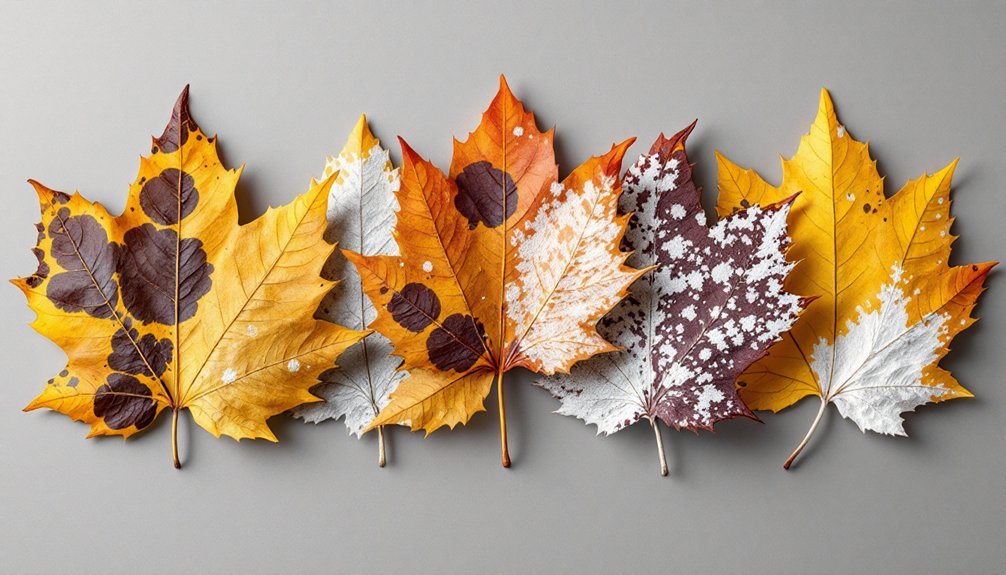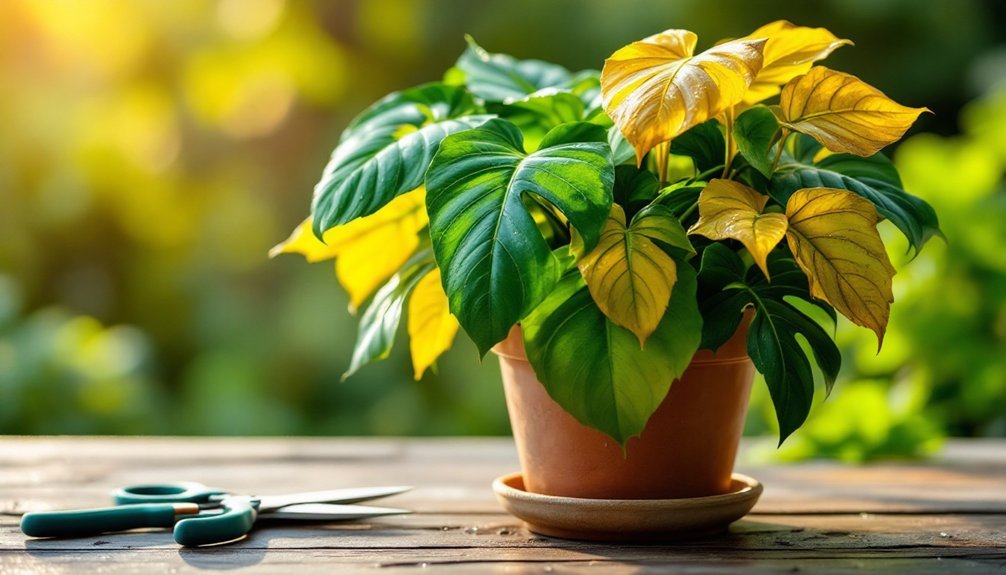You'll spot common plant leaf spots by looking for circular or irregular dark patches, often with yellow halos for bacterial infections or brown-black spots for fungal diseases. Check your plant's lower leaves first, as that's where infections typically start. Watch for spots spreading upward during humid conditions and rainfall. Use a magnifying glass to examine patterns and colors closely. Understanding these key signs will equip you with the knowledge to protect your plants effectively.
Understanding Leaf Spot Development Patterns

When you notice small spots appearing on your plant's lower leaves, you're likely witnessing the early stages of a leaf spot disease. These spots typically progress upward through the plant, especially during periods of high humidity and rainfall.
Lower leaf spots often signal the beginning of leaf disease, climbing upward when moisture levels rise.
As fungal diseases develop, you'll see circular brown or black leaf spots, while bacterial infections often create dark spots surrounded by yellow halos.
Without proper air circulation and spacing between plants, you're creating ideal conditions for pathogen growth. Watch for spots that begin to merge, as this can lead to larger damaged areas and premature leaf drop, which disrupts your plant's ability to photosynthesize.
Environmental factors play an essential role in how leaf spots spread. If you're experiencing wet weather patterns, you'll need to be particularly vigilant, as these conditions often trigger disease outbreaks.
Common Types of Fungal Leaf Spots
Several distinct fungal leaf spots can affect your garden plants, each with unique characteristics that help you identify and treat them effectively.
You'll commonly encounter Alternaria leaf spot on your Brassicas and Cucurbits, where it creates dark, round spots that can severely damage leaves.
If you're growing hardwood trees, watch for Anthracnose's irregular dark spots that often lead to leaf decay.
While bacterial leaf spot isn't a fungal disease, it's often mistaken for one, showing water-soaked spots with yellow halos on flowering plants.
Black spot disease primarily targets roses, creating distinctive round spots with fringed edges.
In humid conditions, you might find Cercospora leaf spot on your beets and cucumbers, appearing as circular dark spots that can quickly spread through your garden.
Bacterial Leaf Spot Characteristics

Bacterial leaf spots reveal themselves through distinctive dark spots surrounded by yellow halos on your plant's foliage.
Dark, sinister spots encircled by yellow halos on leaves signal the unwelcome presence of bacterial leaf spot infection.
You'll notice these small dark brown or black spots appearing on both young and mature leaves, and over time, they'll merge into larger blotches that can seriously damage your plants.
If you're dealing with bacterial leaf spots, you'll need to understand that high humidity and wet leaves create perfect conditions for these pathogens to thrive.
Common culprits like Pseudomonas and Xanthomonas bacteria can quickly spread throughout your garden, leading to premature leaf drop and weakened plants.
To protect your plants, implement effective management strategies: remove infected leaves promptly, apply copper-based bactericides when necessary, and guarantee proper airflow between plants to reduce moisture buildup.
Environmental Factors Affecting Leaf Spots
Understanding environmental factors gives you powerful tools to prevent leaf spots before they take hold. High humidity and excessive moisture create perfect conditions for fungal leaf spot diseases to develop and spread throughout your garden.
When you plant too closely, you'll reduce air circulation, which traps humidity around your plants and slows leaf drying after rain or watering.
Environmental stressors like nutrient deficiencies can weaken your plants, making them more vulnerable to leaf spots, especially during challenging weather conditions.
Watch out for prolonged periods of rain and high temperatures, as these conditions help spread disease spores across your garden.
To protect your plants, guarantee proper spacing, maintain good drainage, and address any nutritional issues promptly. These steps will help create an environment that's less favorable for leaf spot development.
Early Warning Signs and Symptoms

Spotting leaf diseases early can save your garden from widespread damage. When you're inspecting your plants, look for tiny dark brown or black spots on leaves, often surrounded by a distinctive yellow halo. These initial symptoms are telltale signs of leaf spot diseases beginning to take hold.
As the infection progresses, you'll notice these spots becoming darker and developing into raised or sunken lesions. The spots might appear randomly across the leaf surface or follow vein patterns.
Environmental conditions like high humidity and poor air circulation can make your plants more susceptible to these issues. That's why regular monitoring is essential – it's your best defense against severe infection.
Diagnostic Tools and Methods
You'll need two essential tools to start identifying leaf spots: a quality hand lens or magnifying glass for detailed visual inspection, and basic soil testing equipment to check for nutrient deficiencies.
While examining leaves up close, look specifically for distinctive patterns, colors, and textures that can reveal the type of pathogen or problem affecting your plants.
For more complex cases, you'll want access to either a smartphone with plant disease identification apps or professional testing services through your local extension office.
Visual Inspection Techniques Now
To effectively diagnose plant leaf spots, modern visual inspection techniques combine traditional observation methods with contemporary diagnostic tools.
You'll need a magnifying glass to examine the spots' shape, color, and size, helping you distinguish between fungal and bacterial causes. During your visual inspections, pay attention to how the spots are distributed across leaves – whether they're scattered randomly or follow specific patterns along the veins.
Since fungal infections thrive in a moist environment, assess the surrounding humidity levels as part of your examination.
Look for additional symptoms like leaf curling or yellowing that might indicate broader plant health issues. For accurate identification, complement your observations by using smartphone apps and plant databases to compare your findings with documented cases of leaf spot diseases.
Disease Testing Equipment Required
Professional diagnosis of leaf spot diseases requires specific testing equipment and diagnostic tools.
You'll need a microscope to examine leaf tissue for fungal spores and bacterial cells, which helps identify the exact pathogen causing the problem.
Diagnostic kits, particularly ELISA tests, detect specific antigens in infected plant tissues, providing accurate pathogen identification.
To evaluate environmental factors that might contribute to leaf spots, you'll want soil testing kits to measure nutrient levels and pH.
Consider using spore traps to monitor airborne pathogens in your growing area, helping you anticipate potential disease outbreaks.
Digital imaging systems can track disease progression by analyzing leaf symptoms over time.
This combination of tools enables you to make precise diagnoses and develop effective treatment strategies for your plants.
Prevention and Cultural Controls

Maintaining proper spacing between your plants lets air circulate freely, which helps prevent the humid conditions that leaf spot diseases thrive in.
You'll need to keep your garden tools clean and sanitized between uses to avoid spreading pathogens from infected to healthy plants.
When you're planning your garden layout, remember to follow the recommended spacing guidelines for each plant variety, as overcrowding can create the perfect environment for leaf spot diseases to develop.
Proper Plant Spacing Methods
When plants are spaced properly, you'll create an environment that greatly reduces the risk of leaf spot diseases. Aim to space your plants 12 to 24 inches apart, depending on their mature size, to guarantee adequate air circulation and reduce humidity levels that promote infection.
You'll want to avoid overcrowding, which creates shaded spots where moisture lingers on leaves, making them vulnerable to fungal and bacterial pathogens.
Consider using raised beds or incorporating proper row spacing in your vegetable garden to enhance airflow and prevent water from pooling around plant bases.
Keep an eye on your plants as they grow, and don't hesitate to thin them out if they become too dense.
These spacing practices will help you maintain healthy plants and prevent disease prevalence throughout your garden.
Clean Garden Tool Practices
Beyond proper plant spacing, your garden tools can make or break your fight against leaf spot diseases. Good tool hygiene prevents the spread of pathogens between your plants and can greatly reduce contamination risks.
You'll want to disinfect gardening tools regularly with a 10% bleach or 70% isopropyl alcohol solution, especially after working with infected plants.
- Clean tools immediately after use on diseased plants to remove lingering pathogens
- Keep separate tools for different garden areas to minimize cross-contamination
- Store all tools in a dry, clean space to prevent rust and pathogen growth
- Inspect tools regularly for damage that could harbor harmful organisms
- Replace or repair cracked tools promptly, as they're harder to clean effectively
These simple practices will help protect your healthy plants and maintain a thriving garden throughout the growing season.
Natural Treatment Approaches
Several natural treatment options provide effective alternatives to chemical fungicides for managing leaf spot diseases.
You can boost plant immunity by applying compost tea, which contains beneficial bacteria that suppress harmful pathogens. Neem oil serves as a natural fungicide when sprayed regularly on affected plants, disrupting both fungal growth and pest life cycles.
For best results, remove infected leaves promptly to prevent disease spread and create healthier growing conditions.
You'll find that applying a baking soda solution to soil or foliage helps control fungal infections by changing the leaf surface pH.
Consider introducing beneficial bacteria like Bacillus subtilis, which naturally outcompetes harmful pathogens.
These eco-friendly approaches not only treat existing problems but also help prevent future leaf spot outbreaks in your garden.
Chemical Control Options

Chemical fungicides provide targeted control for persistent leaf spot infections when natural treatments prove insufficient.
You'll need to select protective fungicides specifically designed for your plant's pathogen, and copper-based bactericides work well for bacterial leaf spots.
Watch your timing of application carefully – it's most effective to treat at the first sign of infection or when weather conditions favor disease development.
- Choose fungicides matched to your specific leaf spot pathogen
- Apply treatments during dry weather when using copper-based products
- Monitor leaf health regularly to catch problems early
- Time applications before or right when symptoms appear
- Pay attention to weather conditions that could increase infection risk
Remember to follow label instructions precisely and avoid overusing chemical control options to prevent pathogens from developing resistance to treatments.
Recovery and Plant Aftercare
Once you've addressed active leaf spot infections, proper aftercare becomes the key to preventing future outbreaks and restoring plant health.
Start your plant's recovery by implementing correct watering practices – always water at the base to keep leaves dry. Remove infected leaves and maintain regular pruning to improve air circulation throughout the plant's canopy.
Build your soil's fertility by adding organic matter and compost, which will strengthen your plant's natural defenses.
Keep a watchful eye on your plants and act quickly if you spot any disease symptoms returning. For long-term success, consider replacing susceptible plants with disease-resistant varieties in future seasons.
These proactive steps will help guarantee your garden stays healthy and productive while minimizing the risk of leaf spot diseases recurring.
Seasonal Monitoring Strategies
You'll need to establish a year-round monitoring routine that starts with spring disease risk assessments when temperatures begin to warm and humidity levels fluctuate.
During summer months, it's essential to track moisture patterns and inspect your plants weekly for early signs of leaf spots, especially after periods of rain or high humidity.
As fall approaches, you should perform prevention checkpoints by removing infected leaves and documenting any recurring patterns to prepare for the next growing season.
Spring Disease Risk Assessment
As spring's warmer temperatures and increased rainfall create ideal conditions for leaf spot diseases, implementing a strategic monitoring plan becomes crucial for early detection and prevention.
You'll need to assess environmental conditions regularly and adjust your disease management approach to protect your plants during this vulnerable period.
- Check your plants' lower branches daily, as leaf spots often appear first in shaded areas.
- Track local humidity levels and rainfall patterns to anticipate potential fungal infections.
- Evaluate your watering practices, switching to drip irrigation if you haven't already.
- Verify there's adequate spacing between plants to promote proper air circulation.
- Document all symptoms and weather conditions in a gardening journal for future reference.
Remember to focus on prevention by maintaining dry foliage and good ventilation throughout your garden, especially during spring's unpredictable weather patterns.
Summer Moisture Pattern Monitoring
Building on your spring monitoring efforts, summer brings unique challenges for tracking leaf spot diseases. You'll need to closely monitor moisture levels and humidity patterns that can trigger fungal growth during this critical season.
Start by installing rain gauges or moisture sensors to accurately track precipitation and soil conditions. You'll want to prevent excess moisture through careful irrigation practices while maintaining healthy plant hydration.
Watch for early signs of leaf spot development, particularly during periods of high humidity and warm temperatures.
Create a regular inspection schedule to examine your plants' foliage, paying special attention after rain events or heavy morning dew. By tracking these moisture patterns and adjusting your watering routine accordingly, you'll be better equipped to prevent conditions that favor leaf spot diseases in your garden.
Fall Prevention Checkpoints
Fall's arrival marks a critical time to establish prevention checkpoints for managing leaf spot diseases.
You'll need to take proactive steps now to prevent leaf spots from affecting your plants next spring. Monitor environmental conditions closely and document occurrences to identify patterns that may contribute to disease development.
- Inspect your plants thoroughly, paying special attention to lower leaves where leaf spots often begin.
- Prune dense canopies strategically to improve air circulation and reduce moisture buildup.
- Remove fallen leaves and garden debris promptly to eliminate overwintering sites for pathogens.
- Track humidity levels and rainfall patterns to anticipate potential disease outbreaks.
- Keep detailed records of any leaf spot occurrences to refine your prevention strategy for next season.
These checkpoints will help you maintain healthier plants and minimize the risk of leaf spot diseases recurring in your garden.
Best Practices for Healthy Foliage
When maintaining healthy plant foliage, proper cultural practices can markedly reduce the risk of leaf spot diseases. You'll want to focus on adequate air circulation by spacing your plants properly and ensuring you're watering at the base to prevent leaf wetness. Regular inspection enables timely intervention if spots appear, while maintaining soil health through organic matter helps build disease resistance.
| Practice | Benefits | Key Actions |
|---|---|---|
| Spacing | Better air flow | Place plants at recommended distances |
| Watering | Reduces infection risk | Water at soil level, avoid splashing |
| Monitoring | Early detection | Check leaves weekly |
| Prevention | Long-term protection | Choose disease-resistant varieties |
Remember to rotate your crops and incorporate compost to improve soil structure. These practices will help minimize water stress and create an environment that discourages fungal growth while promoting robust plant health.
Frequently Asked Questions
How Do You Identify Leaf Spots?
You'll spot leaf diseases by looking for discolored patches on leaves, checking if they're circular or irregular. Look for yellow halos around dark spots (bacterial) or ring patterns (fungal) on affected foliage.
How Do You Tell the Difference Between a Bacterial and a Fungal Leaf Spot?
You'll notice bacterial spots have yellow halos and water-soaked lesions that merge together, while fungal spots show defined edges with concentric rings. Bacterial spots also spread quickly after leaf damage occurs.
What Are the Splotches on My Plant Leaves?
The splotches on your leaves are likely leaf spot disease, caused by fungi or bacteria. You'll notice dark patches with yellow rings. They're common in humid conditions and can spread if you don't treat them.
How Do You Identify Leaf Problems?
You'll identify leaf problems by looking for dark spots, yellow halos, and discoloration patterns. Check for irregular shapes, sunken areas, and premature leaf drop. Note if spots follow veins or scatter randomly.
In Summary
Stay vigilant with your plant's health by regularly checking leaves for discoloration, spots, or unusual patterns. You'll prevent most leaf spot issues through proper spacing, air circulation, and avoiding overhead watering. If you notice symptoms, don't panic – act quickly with appropriate treatments and improve your plant's growing conditions. With consistent monitoring and care, you'll maintain healthy, vibrant foliage throughout the growing season.





Leave a Reply